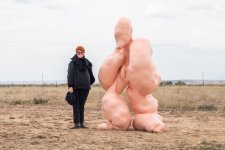This portrait Her Majesty, The Queen, Elizabeth II (Blue) is a photograph created by Polly Borland in 2001. The image is a type C photograph on paper and measures approximately 60 cm high by 50 cm wide. It is surrounded by a wide white mount and narrow light wood frame and is glazed. Queen Elizabeth is at the centre of the image. She wears a bright-blue suit and stands against a flat backdrop with a striking pattern of large flowers.
The background is a Marimekko print of simplified flowers in blues and purples on a white ground. Each flower has rounded petals, a pale centre and a smaller black oval at its heart.
Queen Elizabeth stands front on looking at us. Her hair gleams silver and is combed neatly straight up, curving either side of her forehead in soft curls to just behind her ears. She wears round white pearl earrings.
Queen Elizabeth’s skin is creamy smooth, marked by fine lines across her forehead and around her eyes. Her eyebrows are full, light, and travel down, defining the outer edges of her eyes. A dusting of pale shimmering eyeshadow brightens her eyelids.
Queen Elizabeth’s eyes are sapphire blue. Her nose is straight, two creases run from her nostrils beneath full cheeks to the outer corners of her mouth. Her lips are painted a bright coral pink and are slightly parted, showing the top row of her teeth.
Three strands of matching pearls adorn her neck, resting against the silky blue fabric of her top. A star-shaped brooch, covered in brilliant white diamonds, is pinned to the left shoulder of her suit jacket. Her jacket has notched lapels and is single breasted, fastened together by 3 large round dark-blue pearlescent buttons. It has long sleeves and reaches to hip level. The colour is the same intense electric-blue with a soft sheen as her clothing beneath. However an intricate checkerboard pattern is woven into the fabric.
Queen Elizabeth’s arms are pulled close to her sides. Over her left forearm hangs the black patent leather strap of her handbag and on her wrist is a watch with a gold link band and slim round face. Queen Elizabeth holds her hands in front, the right clasping the left. The skin on her hands is warmer in tone than that of her face and neck. The backs of her hands are marked by age and her unvarnished nails are cut short.
The portrait is cropped at the lower edge just beneath Queen Elizabeth’s hands with only a narrow ribbon of her skirt and handbag included.
Lucinda Shawcross September 2022
Her Majesty Queen Elizabeth II (1926–2022) was the eldest of the two daughters of the Duke and Duchess of York, who became King George VI and Queen Elizabeth. Born in London, she was ten years old when the abdication of her uncle, Edward VIII, and her father’s accession to the throne made her heir presumptive. At 21 she married Philip Mountbatten, who was created HRH Prince Philip, Duke of Edinburgh. In 1952, they set out on a tour of the Commonwealth which was to have included Australia and New Zealand; but on the way, in Kenya, Elizabeth received news of her father’s death. Her coronation took place on 2 June 1953. In 2015, she surpassed the record set by her great-great-grandmother Queen Victoria to become Britain’s longest reigning monarch; and on 6 February 2022 she became the first ever British monarch to mark a Platinum Jubilee.
Melbourne-born Polly Borland was one of few photographers commissioned to take a portrait for Her Majesty’s Golden Jubilee in 2002. Borland was allowed five minutes for the shoot, which was to start as soon as the Queen was in front of the camera. ‘All of a sudden, I see this woman, who’s a lot more petite than I’d imagined, a lot more beautiful than I’d imagined, a lot richer than I’d imagined’, Borland says. ‘I couldn’t talk, I couldn’t remember anything’. Nevertheless, she shot two rolls of film in three minutes, resulting in two portraits. Both are now iconic for their witty, contemporary aesthetic, although the artist still thinks ‘it’s a miracle I got two good photos’.
Purchased 2021
© Polly Borland



On one level The Companion talks about the most famous and frontline Australians, but on another it tells us about ourselves.



Polly Borland talks to Oliver Giles about the celebrity portraits that made her name and why she’s now making more abstract art.



Photographer Polly Borland on capturing Queen Elizabeth II.